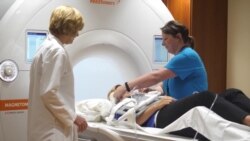MRI scans help doctors diagnose diseases or injuries without radiation. MRI technology uses powerful magnets, radio waves and a computer to make detailed pictures inside the body.
This is especially important for heart patients. With an MRI, doctors can check to see if blood vessels are blocked. They can also check for heart damage after a heart attack.
The downside is that patients must lie motionless in a long tube for a long period of time, which is especially challenging for people with claustrophobia.
University of Missouri School of Medicine researcher Dr. Talissa Altes says the procedure can be very difficult for some patients.
"It can be very hard. It can be very tiring, and they are often very long exams. We schedule them in 90 minute, an hour and a half, slots, which if you have ever been in an MR scanner, that is a long time," Altes said.
In order to get a clear picture, patients must hold their breath, over and over.
"In general, an MRI takes a long time to acquire a single image, and if you are moving during the acquisition of that image, you will get blurring," said Robert Thomen, another researcher on the University of Missouri School of Medicine team.
Thoman and Altes are working on a project called Heart Speed. With Heart Speed, data analysis software pulls out motion information from the magnetic resonance images. Their colleague, Steve Van Doren, says Heart Speed would allow radiologists to see the heart clearly even if a patient is breathing normally.
"We found that we could separate breathing motion from the heart motion quite well using the software, and we thought we should try to start applying this to real patient data," Van Doren said.
The goal? A more comfortable scan for patients who can breathe at a normal pace. Without repeated breath holds, scans would also be much shorter — just 15 to 30 minutes.
"Patients will benefit because it will be easier for them to do the exam," Altes said, adding that "hopefully the radiologist who reads it or the cardiologist who reads the MRI will benefit because the images will be much better."
The researchers estimate the Heart Speed technology will be available for clinical use within five years.





